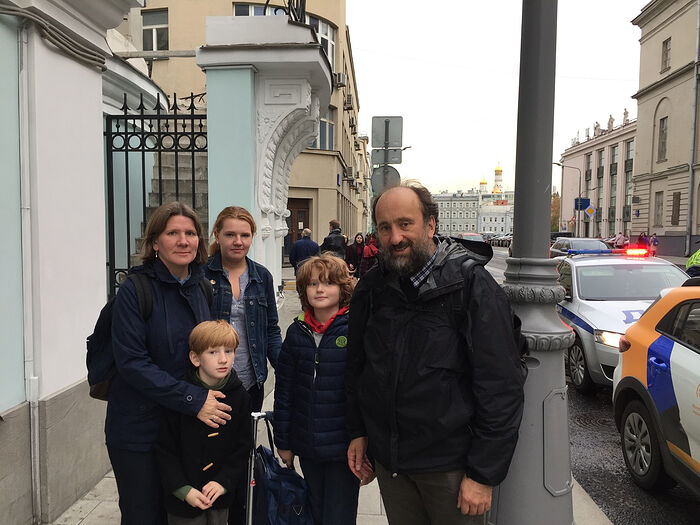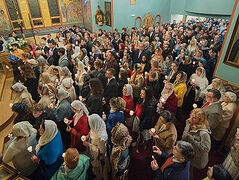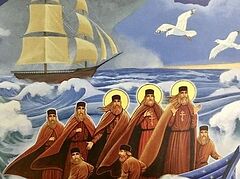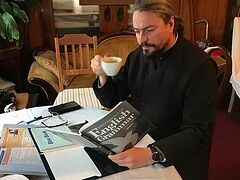Fr. Andrei moved to the USA during Perestroika. Today he is a senior lecturer at the legendary Holy Trinity Seminary in Jordanville and a researcher into the history of the Russian Church Outside Russia. We have talked with Deacon Andrei Psarev on the outstanding alumni of the Seminary, the difficulties of a seminarian’s life, new historical discoveries, and the distinctive Russian culture in the diaspora. COVID-19, the reasons behind The Black Lives Matter phenomenon, and the lessons of Church life.
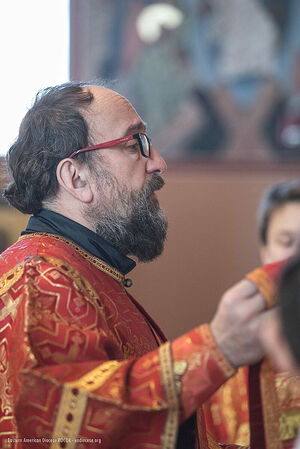 Deacon Andrei Psarev —You moved to the USA in the early 1990s. Has this country become a second home for you? Do you feel homesick?
Deacon Andrei Psarev —You moved to the USA in the early 1990s. Has this country become a second home for you? Do you feel homesick?
—I came to the Holy Trinity Theological Seminary from the Moscow region in August 1990. I had two plans: To become a deacon and to return home. The first plan was implemented, but whether the second one will become a reality I don’t know. I say jokingly that my motherland ceased to exist in 1991. America became my first home. I am grateful to it for showing me how to treat others with respect and for teaching me to put myself into somebody else’s place. Most of what I do in my life is connected with the Russian Orthodox Church. It can be said that I am incurably heartsick for Russia.
—You have lived in Jordanville for quite a long time. Can the Holy Trinity Seminary be characterized as one of the best in the world? How do you personally assess the level of training in this theological school? What advantages of the Seminary can you mention as compared to others?
—The new dean, Dr. Nicolas Yourievich Schidlovsky, Professor of Sacred Music, is working to ensure that the Holy Trinity Seminary trains clergy who are capable of meeting the high expectations of the flock. Knowing the levels of proficiency of the fellow lecturers and seeing how they put their whole souls into their subjects, I can say with certainty that seminarians are given generous attention for solving academic problems and a high-quality religious, theological and humanitarian education. We have an excellent New Testament Greek teacher, Igumen Cyprian (Alexandrou). Professor Elizabeth Purdy is one of the few diplomaed specialists in Church Slavonic in the USA. And Fr. John Boddecker belongs to another rare category—he is an Orthodox Hebraist. Priest Demetrios Harper is the author of a work on the ethics of St. Maximus the Confessor which was recently published by St. Vladimir’s Seminary Press. And Priest John Malcom is working to ensure that our graduates become qualified in clinical consultations which will allow them to work as hospital chaplains.
Another strong side of the Seminary is its participation in the genuinely ascetic tradition that originated in the Dormition Pochaev Lavra and the immersion in the liturgical cycle of the Orthodox Church. The Rector of the Seminary is Bishop Luke (Murianka) of Syracuse, Abbot of the Holy Trinity Monastery, Professor of Patrology, who joined the Holy Trinity Monastery in the mid-1970s.
—Which of the Jordanville fathers left good memories of himself in your heart?
—After the fall of the Berlin Wall in 1989 people in West Germany joked that they wished they could rebuild it themselves because the meeting between the East and the West filled their lives with new problems. In some sense, the same sentiments could be seen in the Russian diaspora. It was easier to idealize and love Russia from a distance. Both sides experienced culture shock from the meeting. The Church diaspora is like a big worldwide community where people share the same cultural code, often know each other’s parents or are related by blood, and share the love for services according to the Typicon and church singing that is typical of the Church diaspora.
 Monk Isaakii (Schotter) is performing obediences at the refectory of the Holy Trinity Monastery. The early 1990s
Monk Isaakii (Schotter) is performing obediences at the refectory of the Holy Trinity Monastery. The early 1990s
Since the rapprochement in 2007 the heightened suspicion concerning “newcomers” has all but disappeared. Back in the 1990s, it was quite strong. It was in that environment that Monk Isaakii (Schotter), a seminary lecturer, became the refuge of “Soviet” seminarians. Perhaps since he was an “outsider” (an Englishman who converted to Orthodoxy), Fr. Isaakii understood our situation.
After serving in the British Army for many years, Fr. Isaakii would show us an example of service. I remember him telling seminarians: “You are ill when an ambulance arrives to take you away.” And even with terminal cancer he would come to perform obediences in the seminary on automatic pilot every day till his final days. It is often said: “See you in eternity!” If we are vouchsafed this, it will be a happy meeting for me as Fr. Isaakii is an example of someone I really miss.
As the editor of the Pravoslavnaya Rus’ weekly periodical of the Holy Trinity Monastery, I worked with Metropolitan Laurus closely for many years. By the example of his life Vladyka Laurus taught us how we should treat our neighbors. He found time for every single person who approached him irrespective of their rank. Even when people committed crimes, he would never shun those in trouble. I remember him saying in one of such occasions: Bear ye one another’s burdens (Gal. 6:2). It was clear how much he was worrying for his brother.
—Continuing the theme of Jordanville figures, can you give us the names of the five to ten most outstanding graduates of the Holy Trinity Seminary?
—I believe that all who wish to share the teaching of Christ with the people of God and the world and enter the Seminary for this purpose are outstanding personalities. As a Russian saying goes, a Church is not made of logs, but of ribs. Over almost seventy-five years of its history since 1948 the Seminary has produced hierarchs, clergy, monastics and faithful Christians for the Church of Christ. They have become the “ribs” of ROCOR and they deserve to be called by name.
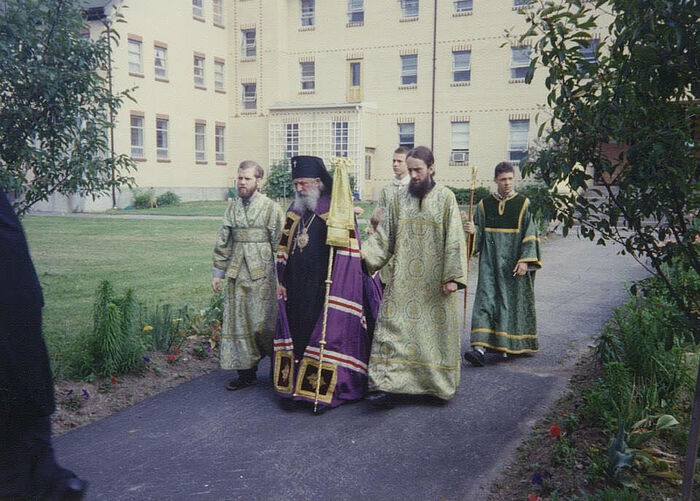 Meeting Metropolitan (then Archbishop) Laurus. The Holy Trinity Monastery. The feast of the Holy Spirit. 1994. Photo by M. Verle
Meeting Metropolitan (then Archbishop) Laurus. The Holy Trinity Monastery. The feast of the Holy Spirit. 1994. Photo by M. Verle
I’d like to point to little known aspects of the lives and activities of some of our graduates. Despite his disrupted secondary education during the Second World War, Archbishop Alypy (Gamanovich) wrote one of the best textbooks on the grammar of Church Slavonic in existence. In the first group of graduates in 1958 together with him was Dmitry (Alexandrov), who afterwards became the first Edinoverie hierarch in the Russian Church—Bishop Daniel—for many years. Protopresbyter Valery Lukianov was aware that his life on earth was nearing its end, but he preached the joy of the Lord with all his might. As the Head of the Ecclesiastical Mission in Jerusalem Archimandrite Roman (Krasovsky) stabilized the position of ROCOR in the Holy Land. The community of St. John the Baptist Cathedral in the U.S. capital, where the rector is Mitred Archpriest Victor Potapov, is one whole despite the use of two liturgical languages at services and is actively involved in social ministry. For fifteen years the Dean of the Cathedral in San Francisco, Archpriest Peter Perekrestov, published The Russian Shepherd magazine that expressed the spirit of the Holy Trinity Seminary students. Priest Nikolaj Kostur, a cleric of the Central American Diocese of the Serbian Orthodox Church, wrote two original works on the history of ROCOR. Reader Ivan Zhigalin works with inmates of a high security prison in Australia, and Mikhail Steblin-Kaminsky works with drug addicts in St. Petersburg.
Another graduate, Juris Narnickis, founded his successful logistic company in Latvia.
—When it comes to students of a theological school in general, the following question suggests itself: Jordanville seminarians—what are they like? Do all of them become priests, and is it only in the Moscow Patriarchate’s and the ROCOR jurisdictions? Are there many seminarians from Russia?
—We have thirty students on our bachelor’s and master’s programs. Additionally, eighteen students study by correspondence. The majority of seminarians are from North America. Of them, the so-called “PKs”—priests’ kids (children of the ROCOR clergy)—can be singled out. Members of the Serbian Church in North America normally study in our Seminary too. By the way, the Seminary has produced many good SOC pastors. Apart from North America, we have seminarians from Spain and the Philippines.
When I enrolled in 1990, there were twenty-one students in our class—most of them came from the USSR (though only seven graduated in 1994). So the fall of the Iron Curtain made the Holy Trinity Seminary appealing to students from the former Soviet republics. Till about 2010 teaching was in Russian. But the Russian language wasn’t common for students and the Americans (both those of a Russian descent and converts to Orthodoxy) who wished to enroll in the Seminary. English is more appropriate for the Lingua Franca mission. When our language in the educational process was changed to English, we managed to attract the category of applicants who couldn’t enter our Seminary before because not everybody can learn Russian at an academic level.
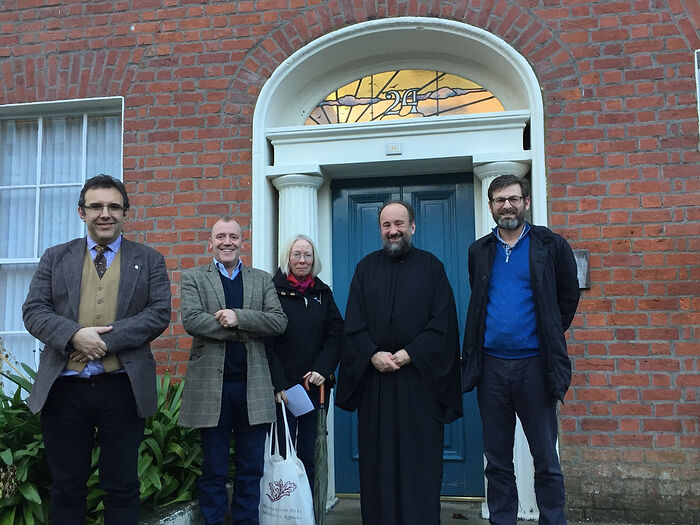 After defending his doctoral thesis at Queen’s University Belfast. 2018
After defending his doctoral thesis at Queen’s University Belfast. 2018
—What are the problems the Seminary is facing today?
—I think the main issue is that the Church isn’t informed enough about the educational and academic processes in the Holy Trinity Seminary and their significance for ROCOR. In addition to basic education at the bachelor’s department we offer in-depth education at the master’s department. Thus we create a staff of our specialists that we don’t have to “export” from other Churches. They could contribute to the development of our Church, say, as experts in Church affairs.
It’s not easy for a seminarian to become a priest. He devotes the most strategically important years of his life to seminary. His secular peers spend their twenties in getting education that will allow them to make a decent living. Meanwhile, parishes as a rule can’t provide a priest with material support that would allow him to fully focus on his ministry. As far as I know, the question of parishioners’ contributions to clergy support hasn’t been looked at for decades.
There are no pensions for our clergy, choir directors and seminary lecturers. It turns out that the current circumstances require that in addition to four years in Jordanville seminarians receive a secular specialty and the skills of obtaining funds before or after arriving here. The immediate victims of this situation are the priest’s life companion and their children. That’s why it is not so easy for them to marry and even more difficult to keep their families. This cruel reality largely explains why our graduates don’t usually fill vacancies as priests in ROCOR. To solve this problem we need interaction with ROCOR hierarchs on specific measures on their part that can improve the financial situation of our pastors. Constant care and collective support could inspire those who are considering entering the Holy Trinity Seminary in the future.
 At St. Sophia’s Cathedral with Dr. V.A. Permyakov and the monastics studying the history of Byzantium at the Holy Trinity Seminary. 2015.
At St. Sophia’s Cathedral with Dr. V.A. Permyakov and the monastics studying the history of Byzantium at the Holy Trinity Seminary. 2015.

